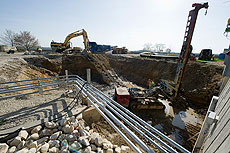New beamlines mean business for contractors
 |
| Construction workers make progress on the New Muon Laboratory expansion project. |
At Fermilab, the Recovery Act is continuing to create jobs for locals, and is helping the laboratory build the infrastructure required to keep the United States at the forefront in the global race for scientific prowess.
This week at the New Muon Lab digging began for a tunnel to house the laboratory's new superconducting radio-frequency test accelerator, which will be the first of its kind.
Like a herd of dinosaurs in a feeding frenzy, huge pieces of equipment circled the north side of the building, moving earth and crushing concrete.
"All this work was done today," said Kyle DeHenau, one of general contractors Barton Malow's on-site supervisors for the NML Expansion Project, raising his voice over the din. "By tomorrow you'll see a big hole in the ground."
Fermilab awarded the Michigan-based firm the $2.8 million contract to complete the 230-foot beam tunnel and two additional buildings. DeHenau said the construction project should be finished by the end of October and will use about 20 local subcontractors.
Wearing a hard hat emblazoned with golden eagles, Bill Neri, owner of Neri Contractors and Excavators of Lake in the Hills, Ill., was directing the fleet of monster diggers and smashers on site. With a handshake worthy of Thor, Neri said that in today's economy, the work was welcome.
"Any kind of earthwork for new construction is good for us," Neri said. "When we're in full swing, the project will have created eight jobs for us."
Fermilab Project Director Jerry Leibfritz said the expansion is key to continuing SRF research at the laboratory for proposed next-generation linear accelerators.
"It gives us the full capability to run tests for future accelerators like Project X and other future projects," he said. "It allows this new facility to become the world-class facility we want it to be. If we hadn't expanded, it would have compromised the science."
-- Andrea Mustain
|